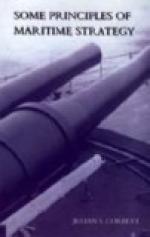EXAMPLES.—This condition of dispute existed during the first three years of the Seven Years War, until Hawke and Boscawen obtained a decision by defeating Conflans and De la Cloue; also in the Great War up to Trafalgar.
SHOULD COMMAND OF THE SEA ALWAYS BE THE
PRIMARY OBJECT?
When the preponderating Power fails or neglects to get command (i.e., leaves the general command in dispute), the disadvantage to him is not so much the danger to his own operations as the facility given to the enemy for carrying out counter operations elsewhere.
Under certain conditions, therefore, it may not be the primary function of the fleet to seek out the enemy’s fleet and destroy it, because general command may be in dispute while local command may be with us, and political or military considerations may demand of us an operation, for which such local command is sufficient, and which cannot be delayed until we have obtained a complete decision.
From the above it will appear “command of the sea” is too loose an expression for strategical discussion. For practical purposes should be substituted “control of passage and communication.”
The question then in the consideration of any proposed operation or line of operations will be, not “Have we the command of the sea?” but “Can we secure the necessary lines of communication from obstruction by the enemy?”
METHODS OF SECURING CONTROL
1. Permanent general control can only be secured by the practical annihilation of the enemy’s fleet by successful actions.
2. Local and temporary control may be secured by:—
(a) A defensive action not
necessarily entirely successful
(containing).
(b) Forcing concentration on the enemy elsewhere (diversion).
(c) Superior concentration
so as to render impotent the enemy’s force
available in the special theatre
of operations (masking or containing).
BLOCKADE
Blockades are of two natures, according to the object review. The object may be:—
(d) Blockade.
i. Close blockade to
prevent the enemy putting to sea. The object
being usually to secure local
or temporary control.
ii. Observation blockade,
to force the enemy to put to sea by
occupying the common lines
of communications (see below). In this
case you are seeking a decision
as a step towards general control.
Both natures are operations upon the lines of passage and communication, but in case (1) the primary intention is defensive, to secure our own line; in case (2) the primary intention is offensive, to seize the enemy’s line and compel him to expose himself in an attempt to recover it.




